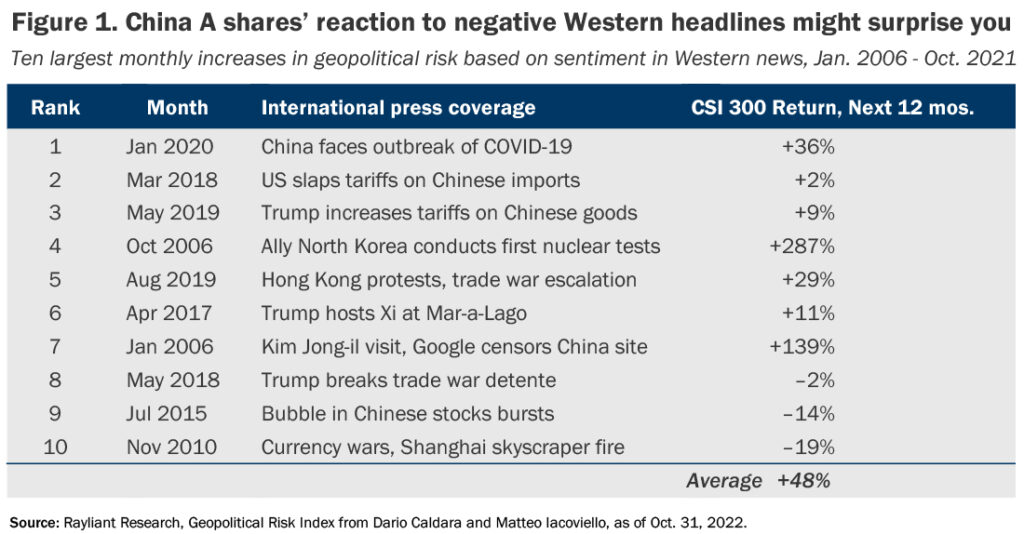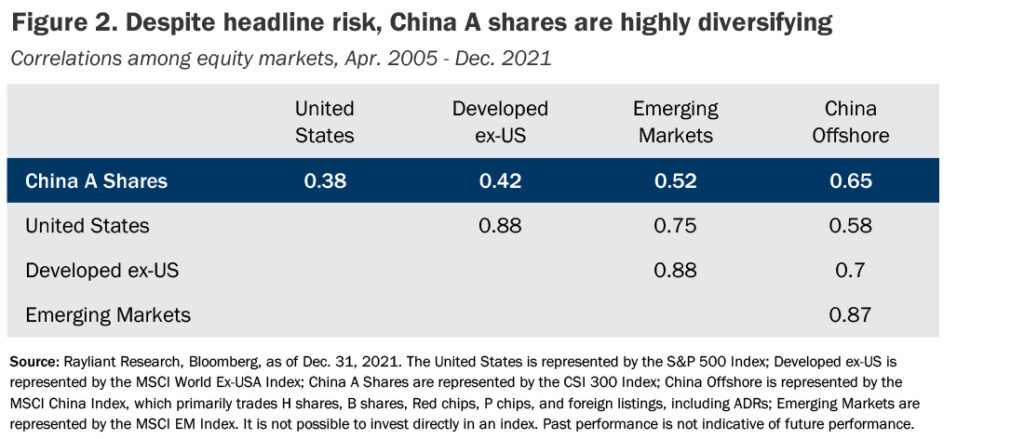This following article was first published to
Jason Hsu’s LinkedIn newsletter, The Bridge.
Subscribe via LinkedIn
Some investors avoid China due to headline risk. But that itself may be the biggest risk of headlines: leading investors to avoid China. In this article I’ll explain why.
“Headline risk” refers to the possibility that a news story will affect the value of an investment. Sometimes headlines cause stocks to rally, and other times to fall. In either case, it’s a risk for investors—something they can’t predict in advance. It makes them nervous.
When it comes to China, being in the headlines is a certainty. But what will those headlines say? Well, that can change from week to week. Sometimes it’s good news. Sometimes it’s bad.
A month ago, after China’s once-every-five-years meeting of the National Congress, headlines projected doom and gloom. But recent reports look more like Bloomberg’s from this past Saturday: “Wall Street’s Chorus of Buy China Calls Is Getting Louder.” This week, headlines have bounced between Xi’s restraint and the end of lockdowns, on the one hand, and a heavy-handed crackdown on protestors with speculation about a nationwide shutdown, on the other.
Ultimately, there’s a lot of noise in the news. You could get whiplash following the headlines about Chinese equities.
Given constant but uncertain news from China, the headline risk may seem high. But here’s the rub: it’s already priced in. Headline risk is only material if risk of bad news has an impact on markets. But when one compares the headlines to the market’s performance, it’s often difficult to see the impact China headlines—whether good or bad—have on mainland stock returns.
To illustrate this, we made a list of the 10 biggest monthly increases in China geopolitical risk, as estimated by Fed researchers, Dario Caldara and Matteo Iacoviello, from the tone of China-related stories in major US newspapers, since the beginning of 2006. We then identified some of the biggest China news stories in those months and calculated China A shares stock returns, represented by the CSI 300 Index, over the next 12 months.

As the table above shows, higher geopolitical risk—which should be a bad thing for investors—doesn’t always correlate to lower returns. Sometimes, it actually precedes major bull runs. In part, that’s because markets often react to major events long before journalists publish their stories: support for conventional Wall Street wisdom advising us to “buy on the rumor and sell on the news.” But it’s also because mainland-traded A shares are sufficiently driven by local retail trading such that they are immunized from international headline risk.
Either way, the A shares market doesn’t seem to care too much about Western press reports.
Setting aside the potential opportunity to buy on a dip and earn a “fear premium” when headlines are relatively daunting, the biggest problem with avoiding China based on headline risk is that it obscures one of the primary reasons to have China exposure in the first place: diversification. A shares are among the least-correlated exposures equity investors can get. Consider the following:

Yes, China equities may move a little based on good or bad news. And yes, the headlines can sometimes swing to extremes, which creates fear and short-run volatility. But even if you believe there is meaningful headline risk, China can still boost a portfolio’s risk-adjusted returns because it brings such strong diversification benefits.
It’s a simple fact that many people invest based on news headlines. That is almost always a losing strategy. Headlines are often biased. Headlines are often reactionary. And even when news is accurate and captures the nuance of political and economic events, the information media reports contain is usually priced into the market long before it hits the press. All of this leads us to conclude that China investors are best served relying on local experts rather than their US newspaper when making portfolio decisions.
Subscribe to receive the latest Rayliant research, product updates, media and events.
Subscribe
Sign upIssued by Rayliant Investment Research d/b/a Rayliant Asset Management (“Rayliant”). Unless stated otherwise, all names, trademarks and logos used in this material are the intellectual property of Rayliant.
This document is for information purposes only. It is not a recommendation to buy or sell any financial instrument and should not be construed as an investment advice. Any securities, sectors or countries mentioned herein are for illustration purposes only. Investments involves risk. The value of your investments may fall as well as rise and you may not get back your initial investment. Performance data quoted represents past performance and is not indicative of future results. While reasonable care has been taken to ensure the accuracy of the information, Rayliant does not give any warranty or representation, expressed or implied, and expressly disclaims liability for any errors and omissions. Information and opinions may be subject to change without notice. Rayliant accepts no liability for any loss, indirect or consequential damages, arising from the use of or reliance on this document.
Hypothetical, back-tested performance results have many inherent limitations. Unlike the results shown in an actual performance record, hypothetical results do not represent actual trading. Also, because these trades have not actually been executed, these results may have under- or over- compensated for the impact, if any, of certain market factors, such as lack of liquidity. Simulated or hypothetical results in general are also subject to the fact that they are designed with the benefit of hindsight. No representation is being made that any account will or is likely to achieve profits or losses similar to those shown. In fact, there are frequently sharp differences between hypothetical performance results and the actual results subsequently achieved by any investment manager.
You are now leaving Rayliant.com
The following link may contain information concerning investments, products or other information.
PROCEED